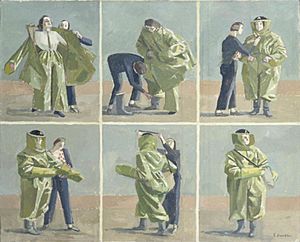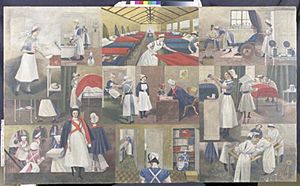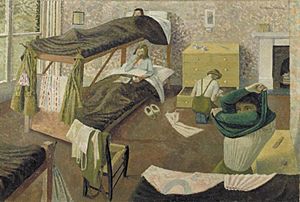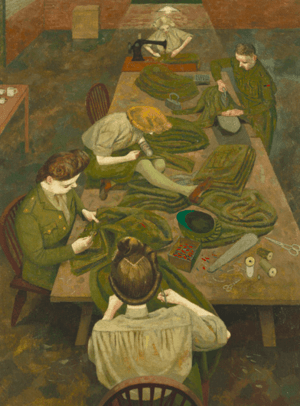Evelyn Dunbar facts for kids
Quick facts for kids
Evelyn Dunbar
|
|
|---|---|
| Born | 18 December 1906 Reading, England
|
| Died | 12 May 1960 (aged 53) Hastingleigh, Wye, Kent, England
|
| Education | Royal College of Art |
| Known for | Painting, murals, illustration |
Evelyn Mary Dunbar (born December 18, 1906 – died May 12, 1960) was a talented British artist, illustrator, and teacher. She is famous for showing how women helped during World War II in the United Kingdom. She especially focused on the work of the Women's Land Army.
Evelyn Dunbar was the only woman who worked full-time for the War Artists' Advisory Committee. This committee hired artists to record the war. She loved nature deeply and especially enjoyed the landscapes of Kent. Evelyn was humble about her own achievements. Her work was not well-known for many years after the war, but it has gained more attention recently.
She painted large pictures called murals at Brockley County Secondary School. She was also a member of the Society of Mural Painters. After the war, she painted portraits, symbolic pictures, and many landscapes. In 1958, she tried to paint another mural at Bletchley Park Teacher Training College, but it was too big a job to finish as planned.
Contents
Early Life and Art Training
Evelyn Dunbar was born in Reading, Berkshire. She was the youngest of five children. In 1913, her family moved to Rochester, Kent. Her father became a tailor there. Her mother loved gardening and painting still-life pictures. She was also a Christian Scientist, and Evelyn followed this faith throughout her life.
Evelyn went to Rochester Grammar School for Girls. She won a scholarship from Kent County Council to attend. She studied art at Rochester School of Art from 1925 to 1927. Then she went to Chelsea School of Art from 1927 to 1929.
In 1929, she won a special award to study at the Royal College of Art. She graduated in 1933. The Tate Gallery bought one of her early student works, Study for Decoration: Flight 1930, in 1940.
One of her teachers at the Royal College of Art was Charles Mahoney. The head of the college, Sir William Rothenstein, encouraged them. Mahoney and a small group of students, including Evelyn, were asked to decorate the assembly hall at Brockley County School for Boys. They painted murals illustrating Aesop's Fables. Evelyn and Mahoney did most of the work, and the murals were officially shown in 1936.
The Brockley Murals
The murals at Brockley County Secondary School were very large. They included five arched panels, a long frieze, and many smaller paintings. The students Violet Martin and Mildred Eldridge painted two panels. Charles Mahoney painted two panels and part of the ceiling.
Evelyn Dunbar painted one large panel, the frieze, and many smaller areas. Her panel showed The Country Girl and the Pail of Milk. The main person in this painting was modeled by her older sister, Jessie. The frieze showed a wide landscape of a place called Hilly Fields. It included dogs, people walking, and boys from the school.
Evelyn and Charles Mahoney spent about three years, from 1933 to 1936, finishing these murals. Evelyn's paintings in these murals showed ideas that would be important in her art later on.
Books and Illustrations
In 1935, Evelyn Dunbar was asked to draw pictures for a book called The Scots Week-End. This book was a collection of stories and advice. Her drawings were done with pen and ink.
This led to a more important book, Gardeners' Choice, published in 1937. Evelyn wrote and illustrated this book with Charles Mahoney. It shared the history and tips for growing 40 different garden plants. Country Life magazine then asked her to create their Gardener's Diary 1938. This was a monthly journal with her own drawings and writings.
In 1941, Evelyn drew pictures for A Book of Farmcraft by Michael Greenhill. This book taught basic farming skills to new farmers. Many of her drawings showed the right and wrong ways to do farm tasks. She drew these at Sparsholt Farm Institute, using new recruits to the Women's Land Army as her models.
Pre-War Artworks
In 1938, Evelyn Dunbar showed four paintings at an exhibition in London. These included An English Calendar, which was a large square painting with 25 sections. Twelve sections showed gardening scenes. Another painting was Winter Garden, from 1929. It showed her family garden in Rochester, with her studio in a small tower on top of the house.
In late 1938, Evelyn opened The Blue Gallery in Rochester. It was a large room above her sisters' shop. She showed her own art there and some of her mother's flower paintings. She also invited other famous artists like Charles Mahoney, Allan Gwynne-Jones, Barnett Freedman, and Edward Bawden to show their work. The gallery opened in March 1939 but closed after only a few months.
World War Two Art
In April 1940, the War Artists' Advisory Committee (WAAC) hired Evelyn Dunbar as an official war artist. She was the only woman artist to get continuous paid jobs throughout the war. Her job was to paint pictures showing how ordinary people helped with the war effort at home.
She first painted the activities of the Women's Voluntary Service (WVS). Later, she focused on the Women's Land Army. By the end of the war, WAAC had accepted about forty of her paintings.
Some of her early war paintings included:
- Putting on Anti-Gas Protective Clothing: This painting was shown at the Tate Gallery in 1940 and in New York in 1941.
- Milking Practice with Artificial Udders: Submitted to WAAC in September 1940.
- Women's Land Army Dairy Training: This painting shows a Land Army recruit learning to move a milk churn.
By November 1940, she had painted Men Stooking and Girls Learning to Stook. This showed the first harvest that the Women's Land Army largely helped with. She also painted A Canning Demonstration, showing how the WVS used the summer's fruit. Her painting A Knitting Party showed about fifteen women, including her mother, knitting blankets for the war effort.
In autumn 1940, Evelyn met Roger Folley, an agricultural economist. They married in August 1942. Roger joined the Royal Auxiliary Air Force in 1939.
Evelyn finished her hospital and nursing paintings in the winter of 1940–41. Hospital Train and Standing by on Train 21 showed how people helped victims of the Blitz. A year later, she painted St Thomas's Hospital in Evacuation Quarters. This painting showed many small scenes of hospital nursing.
WAAC gave Evelyn money to travel. As her relationship with Roger grew, she often followed his RAF postings. When Roger was near Bristol, Evelyn painted WLA activities in Usk, like Sprout Picking, Monmouthshire.
Roger's next posting was in Scotland. There, Evelyn made sketches for Potato Sorting, Berwick. She also painted two scenes of WLA life off-duty: Women's Land Army Hostel and Land Army Girls going to Bed. Singling Turnips was another painting from this time. Her 1943 painting, An Army Tailor and an ATS Tailoress, shows people sewing new uniforms.
In the later war years, Evelyn worked mostly from her studio in Rochester. She got permission to visit RAF South Cerney. There, she completed her only formal portrait for WAAC: Portrait of an Airwoman (1944). This painting is now in the RAF Museum. Also in the RAF Museum is Section Officer Austen, Women's Auxiliary Air Force Meteorologist (1944). By December 1944, she was working on A 1944 Pastoral: Land Girls Pruning at East Malling. This painting showed apple tree pruning at a research station.
The painting The Queue at the Fish-Shop was set in Strood, near Rochester. Evelyn herself looks out of the painting. Her husband, Roger Folley, is cycling into the picture. Her sister Jessie is crossing the road.
Evelyn's last WAAC painting was A Land Girl and the Bail Bull, finished in September 1945. Her sister Jessie modeled for the Land Girl. The 'bail' is a mobile milking shed in the background.
During the war, Evelyn also continued to paint and show her work privately. In 1943, she showed Joseph's Dreams. This was a two-part painting illustrating the Bible story of Joseph. The corn stacks in the painting looked like those in her earlier work, Men Stooking and Girls Learning to Stook.
After the War
After the war, Evelyn and Roger Folley lived in Long Compton, Warwickshire, for about fifteen months. Even with simple studio space, Evelyn painted her first portrait of her husband, Roger Folley. She also painted Dorset, a symbolic painting of a woman looking out to sea.
In 1946, Evelyn started teaching part-time at the Oxford School of Art. She also became a visiting teacher at the Ruskin School of Drawing and Fine Art. To be closer to Oxford, they moved to Enstone, Oxfordshire, in 1947.
At Enstone, Evelyn painted a second portrait of her husband, which he later called The Cerebrant. She also painted The River in Eights Week, 1922 for Worcester College, Oxford. This painting was stolen in 1994. Other paintings from this time include Oxford, a symbolic painting of the university, and Mercatora, about navigation. She also continued her Joseph series with Joseph in the Pit.
In 1950, Roger got a job at Wye College, Kent. They moved to an isolated house near Wye. Evelyn taught informal art classes there. She focused on portraits and landscapes. She also drew nearly 100 diagrams for A Farm Dictionary (1953). Evelyn now had time to paint the beautiful countryside of Kent, which she loved. Her major painting from her later years, Autumn and the Poet, developed slowly over ten years.
By 1953, Evelyn was well-known enough locally to have her only solo exhibition. It was called Evelyn Dunbar – Paintings and Drawings 1938–1953. Six of her WAAC paintings were loaned from the Imperial War Museum for the show.
Alpha and Omega Murals
In 1957, Bletchley Park Teacher Training College asked Evelyn Dunbar to paint a mural. She started working on a large design. However, she soon realized it was too big for her to complete. Instead, she painted two smaller panels. These panels represented the college's motto, Alpha and Omega, which mean "the first and the last."
Alpha and Omega were painted on wood panels. They were placed above the College Library doorways. The letter Omega (Ω) is shown as a yew arch shaped like the letter. The letter Alpha (α) is shown as a simple bugle held by a young boy. These panels are now owned by Oxford Brookes University.
Evelyn also became known for painting children's portraits between 1954 and 1960. These were usually gifts to the families of her friends and relatives. Some of these portraits were not fully finished. In her last few months, she painted her younger nephew, Richard Campbell-Howes, sitting in a chair and reading.
Her Last Years
The last two paintings in her studio when she died were Autumn and the Poet and Jacob's Dream. Autumn and the Poet had taken her ten years to complete. It was a very detailed painting. Roger Folley modeled for the poet, and Roger's sister modeled for the figure of Autumn. This painting was slightly damaged in a fire in 2004 but was restored for an exhibition in 2006.
Legacy and Rediscovery
On May 12, 1960, Evelyn Dunbar suddenly collapsed and died in the woods near her home in Kent. Doctors found that a heart condition caused her death.
When she died, her studio contained many paintings and drawings. Her husband, Roger Folley, remarried in 1961. Evelyn's remaining artwork was given to family and friends. For many years, people thought her post-war work was limited. However, evidence suggests she continued to work constantly and that her art reached its best quality after the war. Many of her watercolors, drawings, and sketches were not seen for years after her death.
In 1961, a stained glass window was made in her memory. It was designed by her friend John Ward and is in the Old Hall at Wye College. It shows flowers from her paintings and says, "In memory of Evelyn Dunbar. Painter and friend of the College 1906–1960."
Her painting A Land Girl and the Bail Bull was shown in the 2005 A Picture of Britain exhibition at Tate Britain. The first book about Evelyn Dunbar was published in 2006.
In 2013, Autumn and the Poet was featured on the Antiques Roadshow TV program. An expert praised it highly and estimated its value to be between £40,000 and £60,000. This encouraged Ro Dunbar, who was married to Evelyn's nephew, to look at a collection of artworks Roger Folley had left in an attic. She thought they were by Evelyn's mother, but they turned out to be more than 500 paintings and drawings by Evelyn herself!
Another nephew had been tracking Evelyn's "lost studio" and making a list of her paintings. This new discovery doubled the number of her known works. The Pallant House Gallery in Chichester held an exhibition called Evelyn Dunbar: The Lost Works from October 2015 to February 2016, showing these newly found pieces.






